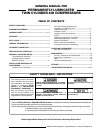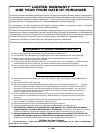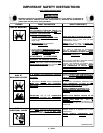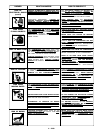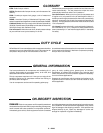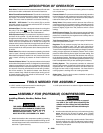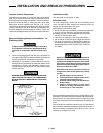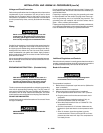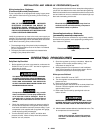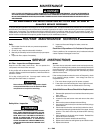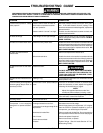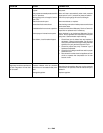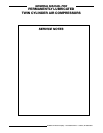
12 — ENG
PROBLEM
CAUSE
Move the pressure switch lever to the “OFF” posi-
tion. If the outfit doesn’t shut off, unplug. If the
electrical contacts are welded together, replace the
pressure switch.
Contact an authorized service center to check and
replace pressure switch.
Tighten fittings where air can be heard escaping.
Check fittings with soapy water solution. DO NOT
OVER-TIGHTEN.
A defective check valve results in a constant air leak
at the pressure release valve when there is pressure
in the tank and the compressor is shut off. Drain tank
then remove and clean or replace check valve. DO
NOT OVER-TIGHTEN.
Remove and replace the release valve.
A defective check valve results in a constant air leak
at the pressure release valve when there is pressure
in the tank and the compressor is shut off. Drain tank
then remove and clean or replace check valve. DO
NOT OVER-TIGHTEN.
Torque head screws to 8 ft. lbs. If this does not stop
leak, replace o-ring.
If there is an excessive amount of pressure drop
when the accessory is used, adjust the regulator
following the instructions on page 6.
NOTE:
Adjust the regulated pressure under flow
conditions (while accessory is being used).
Operate safety valve manually by pulling on ring. If
valve still leaks, it should be replaced.
Remove and clean, or replace.
Decrease amount of air usage.
Check the accessory air requirement. If it is higher
than the SCFM or pressure supplied by your air
compressor, you need a larger compressor.
Clean or replace air intake filter. Do not operate the
air compressor with the filter removed. See page 8.
Check and replace if required.
Remove and clean, or replace.
Tighten fittings. (See Air Leaks Section of Trou-
bleshooting Guide.)
PERFORMING REPAIRS MAY EXPOSE VOLTAGE SOURCES, MOVING PARTS OR COMPRESSED AIR SOURCES. PER-
SONAL INJURY MAY OCCUR. PRIOR TO ATTEMPTING ANY REPAIRS, DISCONNECT POWER SOURCE FROM THE
COMPRESSOR AND BLEED OFF TANK AIR PRESSURE.
CORRECTION
Pressure switch does not shut off
motor when compressor reaches
“cut-out” pressure.
Pressure switch “cut-out” too high.
Tube fittings are not tight enough.
Defective or dirty check valve.
Defective pressure switch release valve.
Defective check valve.
Defective air tank.
Leaking o-ring.
It is normal for “some” pressure drop to
occur.
Possible defect in safety valve.
Defective check valve.
Prolonged excessive use of air.
Compressor is not large enough for air
requirement.
Restricted air intake filter.
Hole in hose.
Check valve restricted.
Air leaks.
Excessive tank pressure - safety
valve pops off.
Air leaks at fittings.
Air leaks at or inside check valve.
Air leaks at pressure switch
release valve.
Air leaks in air tank or at air tank
welds.
Air leaks between head and valve
plate.
Pressure reading on the regulated
pressure gauge drops when an
accessory is used.
Air leak from safety valve.
Knocking Noise.
Compressor is not supplying
enough air to operate accesso-
ries.
DO NOT DRILL INTO, WELD OR OTHERWISE
MODIFY AIR TANK OR IT WILL WEAKEN. THE
TANK CAN RUPTURE OR EXPLODE. TANK
MUST BE REPLACED.
TROUBLESHOOTING GUIDE



